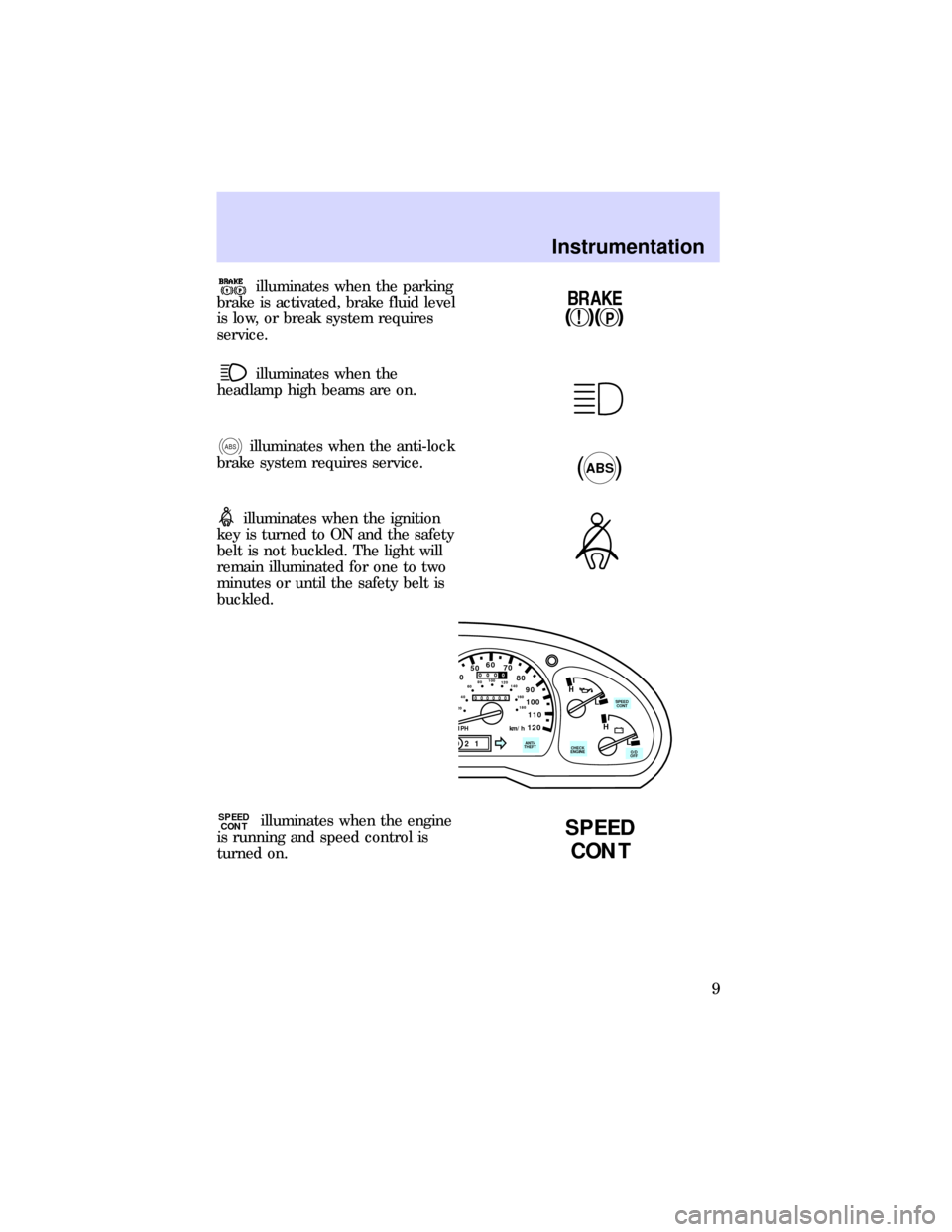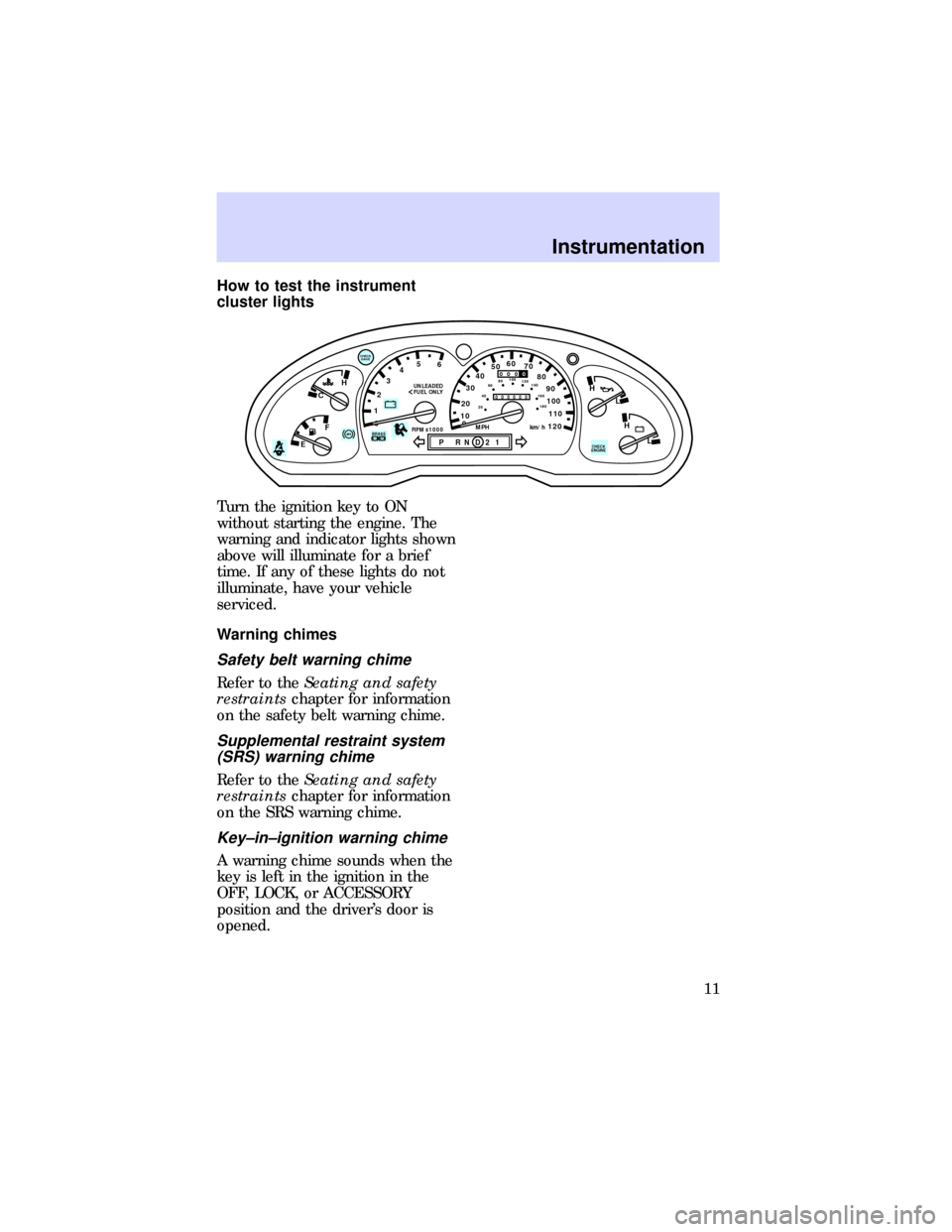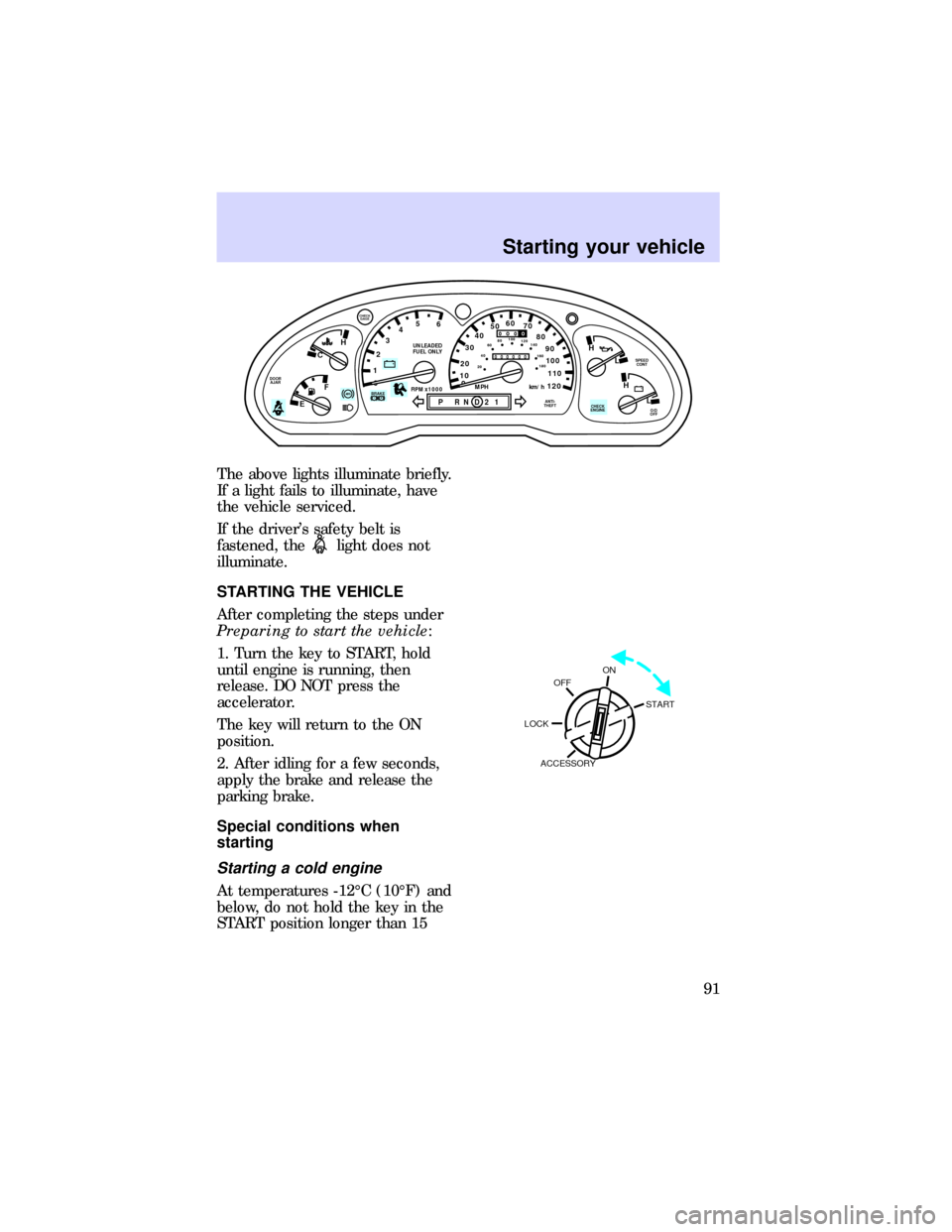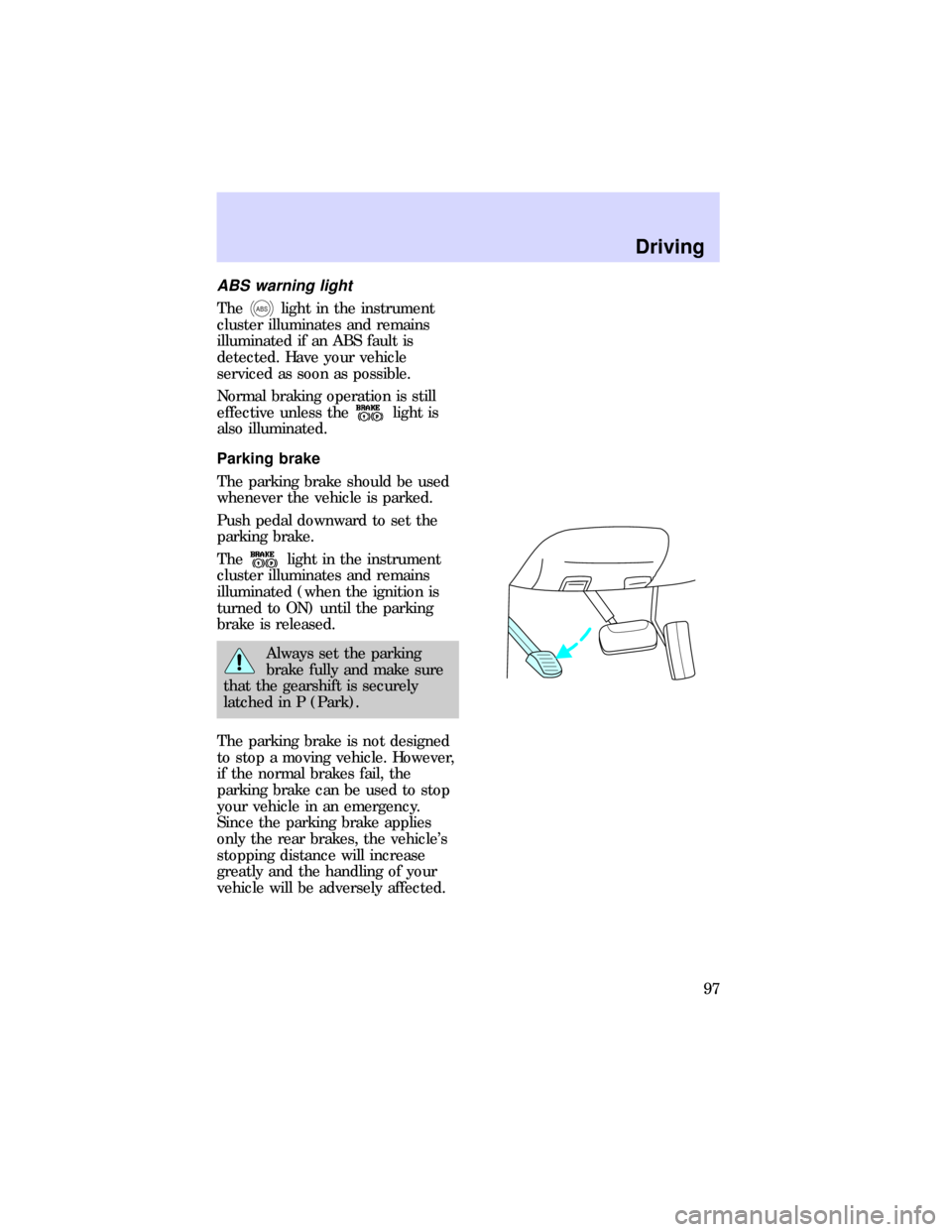service Mercury Mountaineer 1997 Owner's Manuals
[x] Cancel search | Manufacturer: MERCURY, Model Year: 1997, Model line: Mountaineer, Model: Mercury Mountaineer 1997Pages: 197, PDF Size: 2.08 MB
Page 9 of 197

illuminates when the parking
brake is activated, brake fluid level
is low, or break system requires
service.
illuminates when the
headlamp high beams are on.
ABSilluminates when the anti-lock
brake system requires service.
illuminates when the ignition
key is turned to ON and the safety
belt is not buckled. The light will
remain illuminated for one to two
minutes or until the safety belt is
buckled.
SPEED
CONTilluminates when the engine
is running and speed control is
turned on.
!P
BRAKE
ABS
0ABS
- +
P RND21
UNLEADED
FUEL ONLY
RPM x 1000
12345
6
- +
H
H
L L
ANTI-
THEFT
CHECK
ENGINE
O/D
OFF
SPEED
CONT
H
C
F
E
!P
DOOR
AJAR
BRAKE0
20
1030405060
70
80
90
110
120000000
oooo
100
20406080100
120
140
160
180
MPH km/h
SPEED
CONT
Instrumentation
9
Page 10 of 197

O/D
OFFthe transmission control
indicator light (TCIL) illuminates
when the transmission control
switch on the end of the gearshift
lever is pushed and the
D(Overdrive) mode is turned
off.
O/D
OFFindicates the status of the
transmission and may flash steadily
if a malfunction is detected. If
flashing persists, have your
transmission serviced by your
dealer as soon as possible.
If this condition persists, your
transmission may be damaged.
CHECK
ENGINEilluminates when the
emission control system requires
service.
THEFT(if equipped) illuminates
when the anti-theft system is
arming and flashes when the
anti-theft system is armed. Refer
toInterior featuresfor additional
information regarding the
anti-theft system.
illuminates when the left-
hand or right-hand turn signal or
the hazard lamps are illuminated.
O/D
OFF
CHECK
ENGINE
THEFT
Instrumentation
10
Page 11 of 197

How to test the instrument
cluster lights
Turn the ignition key to ON
without starting the engine. The
warning and indicator lights shown
above will illuminate for a brief
time. If any of these lights do not
illuminate, have your vehicle
serviced.
Warning chimes
Safety belt warning chime
Refer to theSeating and safety
restraintschapter for information
on the safety belt warning chime.
Supplemental restraint system
(SRS) warning chime
Refer to theSeating and safety
restraintschapter for information
on the SRS warning chime.
Key±in±ignition warning chime
A warning chime sounds when the
key is left in the ignition in the
OFF, LOCK, or ACCESSORY
position and the driver's door is
opened.
0ABS
- +
P RND21
UNLEADED
FUEL ONLY
RPM x 1000
12345
6
- +
H
H
L L
CHECK
ENGINE
H
C
F
E
!PBRAKE
CHECK
GAGE
0
20
1030405060
70
80
90
110
120000000
oooo
100
20406080100
120
140
160
180
MPH km/h
Instrumentation
11
Page 72 of 197

passenger in the event of a
collision.
All occupants of the
vehicle, including the
driver, should always wear their
safety belts, even when an air
bag supplemental restraint
system is provided.
Do not place objects or
mount equipment on or
near the air bag cover on the
steering wheel or in front seat
areas that may come into contact
with a deploying air bag. Failure
to follow this instruction may
increase the risk of personal
injury in the event of a collision.
Do not attempt to service,
repair, or modify the air
bag supplemental restraint
system or its fuses. See your
Ford or Lincoln-Mercury dealer.
Rear-facing child seats or
infant carriers should
never be placed in the front seat.
Air bags and air bag equipped
vehicles should be disposed of only
by your dealer.
Seating and safety restraints
72
Page 74 of 197

bags, and the air bags deflate. You
may notice smoke and smell the
escaping gas after the air bags
deflate. This is normal.
You and your passenger must wear
your safety belts in order for the
air bag system to operate
effectively.
AIR BAG WARNING LIGHT AND
CHIME
When you turn the ignition key to
the ON position, the
warning
light in the instrument cluster
illuminates for approximately six
seconds to indicate the air bag
system is functional.
If you hear a group of five beeps,
or if the
warning light does
not illuminate, stays lit, or flashes,
the air bag system requires
immediate service. Have the
vehicle serviced at your dealer.
CHILD RESTRAINT
PRECAUTIONS
You are required by law to use
safety restraints in the United
States and Canada. If small
children ride in your vehicle
(generally children who are four
years of age or younger and who
weigh 18 kg [40 lb or less]), you
must put them in safety seats
made especially for children.
Check your local and state laws for
specific requirements regarding the
safety of your children.
Seating and safety restraints
74
Page 91 of 197

The above lights illuminate briefly.
If a light fails to illuminate, have
the vehicle serviced.
If the driver's safety belt is
fastened, the
light does not
illuminate.
STARTING THE VEHICLE
After completing the steps under
Preparing to start the vehicle:
1. Turn the key to START, hold
until engine is running, then
release. DO NOT press the
accelerator.
The key will return to the ON
position.
2. After idling for a few seconds,
apply the brake and release the
parking brake.
Special conditions when
starting
Starting a cold engine
At temperatures -12ÉC (10ÉF) and
below, do not hold the key in the
START position longer than 15
0ABS
- +
P RND21
UNLEADED
FUEL ONLY
RPM x 1000
12345
6
- +
H
H
L L
ANTI-
THEFT
CHECK
ENGINE
O/D
OFF SPEED
CONT
H
C
F
E
!P
DOOR
AJAR
BRAKE
CHECK
GAGE
0
20
1030405060
70
80
90
110
120000000
oooo
100
20406080100
120
140
160
180
MPH km/h
ON
START
LOCK
ACCESSORYOFF
Starting your vehicle
91
Page 94 of 197

GUARDING AGAINST EXHAUST
FUMES
Carbon monoxide, although
colorless and odorless, is present
in exhaust fumes. Take precautions
to avoid its dangerous effects.
If you smell exhaust fumes
inside your vehicle, have
your dealer inspect your vehicle
immediately. Do not drive if you
smell exhaust fumes.
Have the exhaust and body
ventilation system checked
whenever:
²The vehicle is raised for service.
²The sound of the exhaust
system changes.
²The vehicle has been damaged
in a collision.
Starting your vehicle
94
Page 96 of 197

BRAKES
The anti-lock brake system
(ABS)
Anti-lock brake operation differs
slightly from standard brake
operation.
Apply the brakes steadily. DO NOT
pump the brakes in a panic stop.
The brake system will prevent
wheel lockup by automatically
releasing and reapplying the
brakes.
Even with ABS, the brakes could
lock up on roads with alternating
slippery and dry patches or with
loose surfaces such as snow or
gravel. Be careful when braking.
The ABS conducts a self-test each
time the vehicle is driven. A
mechanical noise may be heard
while the system conducts its
self-test.
Occasional brake squeal during
light to moderate stops is normal.
Significantly increased squeal is an
indicator that brake service is
needed.
After driving through standing
water, gently apply the brakes
several times to dry them.
If driving down a long or steep hill,
shift to a lower gear and do not
apply the brakes continuously.
Continuously applying the brakes
on a hill could overheat them and
make them less effective.
Driving
96
Page 97 of 197

ABS warning light
TheABSlight in the instrument
cluster illuminates and remains
illuminated if an ABS fault is
detected. Have your vehicle
serviced as soon as possible.
Normal braking operation is still
effective unless the
light is
also illuminated.
Parking brake
The parking brake should be used
whenever the vehicle is parked.
Push pedal downward to set the
parking brake.
The
light in the instrument
cluster illuminates and remains
illuminated (when the ignition is
turned to ON) until the parking
brake is released.
Always set the parking
brake fully and make sure
that the gearshift is securely
latched in P (Park).
The parking brake is not designed
to stop a moving vehicle. However,
if the normal brakes fail, the
parking brake can be used to stop
your vehicle in an emergency.
Since the parking brake applies
only the rear brakes, the vehicle's
stopping distance will increase
greatly and the handling of your
vehicle will be adversely affected.
Driving
97
Page 105 of 197

that could damage drive
components.
If the transmission and transfer
case are submerged in water, their
fluids should be checked and
changed, if necessary.
All rear axle lubricants must be
replaced every 160,000 km
(100,000 miles) or if the axle has
been submerged in water.
Otherwise, check the lubrication of
the rear axle according to the
intervals in theService Guide.
Driving on hill or slope terrain
When driving on a hill, avoid
driving crosswise or turning on
steep slopes. You could lose
traction and slip sideways. Drive
straight up, straight down or avoid
the hill completely. Know the
conditions on the other side of a
hill before driving over the crest.
When climbing a steep hill, start in
a lower gear rather than
downshifting to a lower gear from
a higher gear once the ascent has
started. This reduces strain on the
engine and the possibility of
stalling.
When descending a steep hill avoid
sudden braking. Rapid pumping of
the brake pedal will help slow the
vehicle and still maintain steering
control.
When speed control is on and you
are driving uphill, your vehicle
speed may drop considerably,
especially if you are carrying a
Driving
105